In over 35 years of practice, I have never lost one heart-attack patient. That’s a pretty remarkable claim to make, but Dr. John Christopher, the famous master herbalist, said it with confidence.
“If they are still breathing, I give them a cup of cayenne tea (a teaspoon of cayenne in a cup of hot water), and within minutes they are up and around.”
Cayenne? The pepper? That’s right! Cayenne is one of the fastest-acting aids for the heart, because it reaches the heart immediately.
Here’s how it works: Cayenne helps maintain the river of life: the bloodstream. A stagnated river leads to blockages, which lead to oxygen starvation. Oxygen starvation leads to organ dysfunction, disease, and – in severe cases – heart attack. Cayenne pepper works like a drain opener that blasts through the blockages, delivering oxygenated blood into sick or dying organs faster than any other medicine or herb can get there.
In fact, cayenne has more health benefits than any other single food or herb on earth.
Cayenne taken internally as a tea will stop the bleeding — even from a severe cut or gunshot wound — in most cases by the time you can count to ten. Cayenne has a natural, powerful, equalizing effect on blood-pressure. When it hits your bloodstream — which it does immediately — it adjusts your blood pressure from the top of your head to the bottom of your feet. Thus, the high pressure at the wound site is alleviated and clotting can start at once.
Cayenne is truly a gift to humanity. Over 3,000 scientific studies listed in the National Library of Medicine support the use of cayenne in preventing and reversing many common health ailments.
So … What’s the Catch?
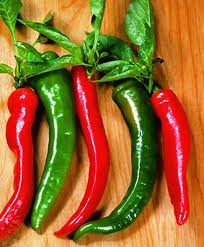 Not all cayenne peppers are the same! Each of the many varieties has a different use and level of heat. Heat (or “Scoville”) units are determined by the quantity of chemicals in the cayenne and its resins. The higher the level, the hotter the cayenne pepper — and the hotter the pepper, the stronger and more effective a healer it is.
Not all cayenne peppers are the same! Each of the many varieties has a different use and level of heat. Heat (or “Scoville”) units are determined by the quantity of chemicals in the cayenne and its resins. The higher the level, the hotter the cayenne pepper — and the hotter the pepper, the stronger and more effective a healer it is.
Cayenne peppers range from 0 to 300,000 heat units. The spice-cabinet variety averages 5,000 heat units. Paprika has no heat and is rated 0 heat units. Jalapeño peppers are between 50,000 and 80,000 heat units; Serrano peppers are approximately 100,000 heat units. African Bird Peppers average 200,000 heat units and Mexican habañeros are between 250,000 and 300,000 heat units.
Ultra-hot cayenne tincture from 300,000-heat-unit organic habanero peppers will increase your blood flow almost instantly, bringing in new oxygen to your body’s vital organs, muscles, and tissues, and, at the same time, carrying away toxic wastes from these same areas in its return flow.
A Virtual “White Light”
Dick Quinn described his out-of-body experience he’d had when he “died” from a massive heart attack, but was then revived. With fully blocked arteries, he was given a choice: multiple-bypass surgery or death. Unfortunately, the surgery failed; several weeks later, Dick was still dying a slow, painful death.
This time, his doctors only gave him one choice: another bypass. He refused. His cracked ribs still hadn’t healed from the first time; his pain was excruciating; and he didn’t see how a repeat of the same surgery could improve his condition.
Since Dick had refused surgery and the drugs weren’t working, his doctors discharged him.
Dick went home to die — and for several weeks, that’s how it looked. His condition worsened daily until it took every ounce of his strength just to get to the bathroom. He could barely catch his breath. His skin was gray – his body was getting no oxygen. He was cold and miserable all the time.

One day while sitting in a park letting the sun warm him, he had either a divine or serendipitious experience: a woman abruptly walked over and told him to use cayenne pepper for his condition. After politely asking her to leave him alone, as he was busy dying, Dick went home and forgot about her.
A few weeks later, feeling worse than ever, he remembered the encounter. In desperation, he decided to try some cayenne. He figured the worst it could do was kill him –– and he was already dying, anyway.
Dick emptied a couple of heart-medication capsules and refilled them with cayenne from his spice cabinet. The results were miraculous — not only did he recover, he wrote up his story for all to read in Left For Dead, which you can buy on the Internet or at most health-food stores. Dick was 42 when he had his heart attack; at 58, he could be found on a world-wide, 300-day-a-year lecture circuit, sharing the life-saving benefits of cayenne.
Cayenne is better than a cup of coffee for energy, mental clarity, and being kind to the body since it doesn’t wipe out the adrenal glands with harmful stimulants. Cayenne has so many positive effects on the body, the list seems endless, especially since most health problems start with a lack of circulation triggered by anything from clogging foods, medications, lack of exercise, depression, etc.
One Success Story After Another
Many BASTIS Foundation clients have animal companions who also need help. One young pug was brought in with sudden deafness and dizziness, according to her “father.”
Pugs tend to have difficulty breathing and she had just had sinus surgery followed by the usual antibiotics. Soon she was walking into walls. She didn’t respond to any noises whatsoever — not even her dinner bell.
We suspected a bad reaction to the antibiotics and recommended a teaspoon of cayenne tincture poured down her throat to blast her nerves back into action.
Whoa! Talk about a pug with bugged-out eyes! The little girl rubbed her face all over the floor, wriggled on her back and rubbed at her ears with her paws for close to five minutes. Then her ‘dad’ called to her. She jumped up and ran to him! To this day, she’s jumping, snorting, and racing to her food bowl whenever she’s called.
Incision Begone!
Beth had emergency surgery for adhesions that were strangulating her colon after an earlier surgical procedure. Hospitalized for two weeks, her 16-inch “stem-to-stern” incision became dangerously infected just as she was about to be discharged –– not an uncommon problem, since anyone in a weakened state is susceptible to the unlimited infections floating around a hospital. This required two more weeks of hospitalization, but Beth’s condition only worsened. After her fourth week in the hospital, Beth desperately wanted out, so she signed a release, agreed to retain the services of a home nurse and went home with a BASTIS Foundation caregiver.
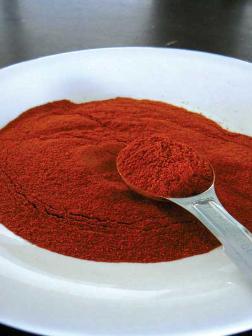 The nurse came, checked the dressing, and left instructions that it be changed twice a day. Before she left, she warned Beth to expect a long healing process.
The nurse came, checked the dressing, and left instructions that it be changed twice a day. Before she left, she warned Beth to expect a long healing process.
The BASTIS Foundation caregiver poured four ounces of 300,000-heat-unit habañero tincture right into the wound, then took Beth’s hand and waited for the screams, because it was so hot that one drop would make your eyes bug out when it hit your tongue.
Beth was silent.
She felt no pain, she said. An hour later, however, the incision was “on fire.” Another hour passed, and the fire –– and pain –– were gone.
When the nurse returned the next morning to check on the infection, she was shocked! Overnight, the oozing had stopped and the incision had started closing –– in less than 24 hours, the infection was disappearing.
Cauterization in a Jar
Inga showed up with a gushing index finger after accidentally cutting off its tip with a miter saw five hours earlier. Although bleeding non-stop, she had been turned away by the local hospital as she had no insurance.
Inga was extremely pale and dizzy when she arrived. We stuck her finger into a jar of powdered cayenne made from African Bird peppers (approx. 200,000 heat units). At first the pain was pretty intense, but no worse than it had been the previous few hours.
We wrapped the finger with cayenne powder clinging to the open wound. The cayenne had already cauterized the wound, so the bleeding had stopped. The following is a letter the BASTIS foundation received some time later.
I just wanted to drop you a note to thank you for healing my index finger on my left hand.
As you might recall, on August 19, 1998 at 3:00pm I came to your office with an emergency. I had accidentally touched the blade of the mitre saw while it was in operation. It only took this split second contact with the saw blade to cut out the flesh on my index finger almost to the bone, leaving nothing left to be stitched.
You cleansed my profusely bleeding finger, then proceeded to pack it into cayenne pepper, covering the entire wound. I was rather skeptical of this procedure, but it worked! The bleeding stopped and the pain iterally had vanished by dinner time, without “painkillers!”
The next day you instructed me to cleanse the wound and apply calendula ointment and tea tree oil twice a day. In wonderment I observed my finger heal rapidly from hour to hour. It was miraculous!
Anyway, to make a long story short, after several weeks my finger was healed without any infection. I still have a minimal “dent” where the flesh was sawed out, but I have full use of my finger, no nerve damage etc.
Your quick certainty on how to treat such an injury effectively was quite impressive and confidence inspiring.
THANK YOU FOR A MIRACLE!
Warmest Regards,
Inga K.
What Inga didn’t mention in the letter was that one of her associates did the exact same thing a week later — only he had insurance and was given emergency medical care at a hospital, where he received a skin graft from his hip to cover the tip of his finger. Now, more than six years later, he still experiences pain and an uncomfortable tingling, and is missing the top portion of his finger. If he had not had insurance, Inga might have advised him to pack his finger in cayenne, which is what encouraged the flesh to grow back into place. Why? Because cayenne promotes live-tissue regrowth.
How does that happen? Here’s an old story, well known by heavy-duty cayenne lovers, that has been repeated in a number of publications. A team of research doctors put some live heart tissue into a sterile beaker filled with distilled water, and fed it nothing but cayenne pepper. All they did was clean off the sediment periodically, add distilled water to compensate for natural evaporation — and trim it every few days.
The tissue grew continuously. It had no control glands, such as pituitary or pineal glands, but it just continued growing –– rapidly. The doctors and their associates kept the heart tissue alive for seventeen years before destroying it so they could do other, unrelated research work on it.

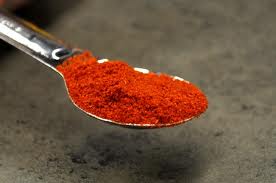 surgery. Most, in fact, report feeling worse and come to us as a last resort. Some have been on so many medications that they could barely walk; their organs were threatening to shut down or were in the process of doing so.
surgery. Most, in fact, report feeling worse and come to us as a last resort. Some have been on so many medications that they could barely walk; their organs were threatening to shut down or were in the process of doing so. 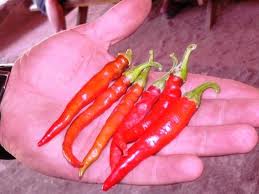 intimidating neurosurgeon told his family and friends in the emergency room that he wanted to admit John as a patient immediately so an oncological team could drill into the cerebellum to relieve the pressure. If there was indeed a tumor, they would remove it, even before verifying whether it was malignant.
intimidating neurosurgeon told his family and friends in the emergency room that he wanted to admit John as a patient immediately so an oncological team could drill into the cerebellum to relieve the pressure. If there was indeed a tumor, they would remove it, even before verifying whether it was malignant.  Reynaud’s is severe enough that she experienced an aortal spasm several years ago –– a very painful contraction of the main artery leading off the heart. Today, Claudia takes cayenne in capsule form three times a day. When she has a Reynaud’s attack, during which the blood vessels in her extremities spasm, she immediately pops two cayenne capsules along with a dose of
Reynaud’s is severe enough that she experienced an aortal spasm several years ago –– a very painful contraction of the main artery leading off the heart. Today, Claudia takes cayenne in capsule form three times a day. When she has a Reynaud’s attack, during which the blood vessels in her extremities spasm, she immediately pops two cayenne capsules along with a dose of 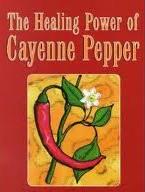 Millions of Americans whip their heart with nitroglycerin, digitalis or some other drug, forcing it to beat rapidly to keep it going. Remember, though, that most heart attacks are due to the heart being malnourished; it hasn’t had a decent meal for so long, it’s practically starved. Cayenne, when fed to the tongue directly in a warm liquid base (such as water), instantly opens and expands the very cells of the circulatory system, which instinctively distributes the cayenne where it is now needed –– in this case, the heart.
Millions of Americans whip their heart with nitroglycerin, digitalis or some other drug, forcing it to beat rapidly to keep it going. Remember, though, that most heart attacks are due to the heart being malnourished; it hasn’t had a decent meal for so long, it’s practically starved. Cayenne, when fed to the tongue directly in a warm liquid base (such as water), instantly opens and expands the very cells of the circulatory system, which instinctively distributes the cayenne where it is now needed –– in this case, the heart.